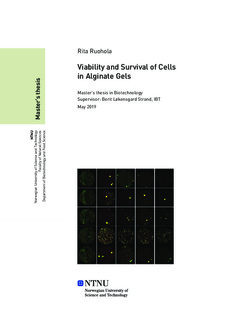| dc.description.abstract | Different biomaterials are studied for purposes of tissue engineering, drug development and many fields of research to serve as scaffolds for three-dimensional (3D) cell cultures to provide more authentic and tissue-like microenvironments for cells. A common approach for this is the use of hydrogels as the culture matrix. Use of hydrogels aims to mimic in vivo environment and provide more reliable results from in vitro studies.
Hydrogels are three-dimensional polymer networks with a flexible structure and resemblances to a natural extracellular environment with a high content of water. Those can be modified to obtain different mechanical and chemical features and have proven to be well suited for the purpose of biomaterial use. One of the most studied material for hydrogels for these purposes is alginate. Alginate is biopolymer originating commonly from algae and it has been shown to have many interesting and desirable features for biomaterial use. In this thesis a matrix material with the ability to support cell viability, survival and proliferation was searched through multiple screening experiments of different alginate-based hydrogels for encapsulation and cultivation of mammalian cells.
In the experiments conducted within this study, the cell viability inside and on top of the alginate-based hydrogels was followed over time periods from five to ten days. During these periods the cells were inspected at multiple time points and the overall survival was determined by Live/Dead assaying to qualitatively assess live and dead cells throughout the experiment. Furthermore, the morphology of the cells was also investigated in order to determine the capability of the material to promote cell attachment. The ability of cells to attach to their matrix is considered important for their viability and normal function. Two different cell lines were utilized in the experiments and the results obtained with each line were used to evaluate the viability promoting features of the gel matrix. The used cell lines were liver-derived HepG2 line and a myofibroblast line IMR90.
In the series of experiments, it was found that the use of alginate with incorporated RGD-peptide had a significant influence on promoting cell attachment when compared to gels with only unmodified alginate. Gels with different laminin peptides were also studied but these were not found to produce a similar effect as the RGD-peptide with both cell lines. Especially important the incorporation of RGD-peptide was found to be for the IMR90 cell line. The adhering of cells was further improved by increasing the amount of this cell attachment promoting peptide in the gels. The attachment implying morphology changes was only discovered in gels with 1% of alginate. Gels with a higher total amount of alginate were predicted to be harder to penetrate for cells due to higher stiffness of gels. Gels with RGD-modified alginate and less than 1% alginate were not studied because it was susceptible if this would make a stable gel.
Different treatment procedures were also studied in order to increase the survival of cells during the encapsulation process. It was concluded that by exposing cells to hypothermic conditions (+4 °C) before encapsulation the cells had a slightly higher rate of survival when compared to cells encapsulated in RT conditions. Washing of the alginate gels with cell culture media after encapsulation procedure was also found to improve cell survival. The effect of the total cell number on cell survival was studied briefly in the experiments. The results suggested that by increasing cells concentration from initial 7,7×105 cells/ml to a double or more the cells might have been more prone to adhere to the material. However, increasing of the cell number could reduce the survival rate of the encapsulated cells due to higher demand for oxygen and nutrients. | |
